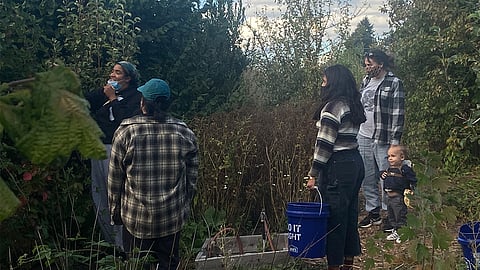BLOOM Giving Garden Teaches BIPOC Youth Black Liberation and Food Sovereignty
by Chamidae Ford
As we transition into fall, the BLOOM Giving Garden at Wa Na Wari is beginning to wrap up the season. The BIPOC-youth-run garden began as a response to COVID-19 and has continued to grow and expand in its second summer.
The garden is a collaboration between Wa Na Wari, Seattle Public Library (SPL), YES Farm, The Black Farmers Collective, and EarthCorps. The project aims to educate and uplift BIPOC youth by fostering food sovereignty and honoring sacred land and Indigenous practices whilst building community. Eight fellows have been selected to run the garden through their involvement with farm-related programs.
C. Davida Ingram, a Wa Na Wari partner and SPL public engagement employee, teamed up with Hannah Wilson from YES Farms and came to Wa Na Wari with the idea for a garden.
"Our goal is to look at the environment that Communities of Color look in, live in, and to look at it through the lens of creativity," Ingram said. "At the beginning of the pandemic, there was a spotlight on economics. People were losing their housing and also people were running out of food. And because Seattle is such an incredible space for conversations around food justice and food sovereignty, we reached out to Wa Na Wari and said, 'Would you be interested in creating a space where people could learn about food sovereignty and also would you be open to creating space for community gardening?' And they said 'yes.'"
BLOOM focuses on reconnecting BIPOC youth with their cultures, from growing food that is traditionally found in their cultural cuisine to learning about the history of BIPOC farmers.
"The garden tends to revolve around the notion that while we may have different lands of origin, we typically, as BIPOC communities, have had some kind of relationship with colonization that pushed us away from our ancestral diet," Ingram said. "So we use the space of BLOOM to think about things like Indigenous sovereignty on the hyper-local level; of course, we are on Coast Salish lands. There's no part of Turtle Island or the U.S. — which is its settler name — that is not Indigenous lands."
And while BLOOM fosters community for those involved, it also gives back to the community it is a part of. One of the BLOOM fellows, Ozzy Ramos, went around the community and found residents with fruiting trees in their yard that they could not keep up with. Instead of letting the fruit rot, fellows went out and picked the fruit and then worked with a community pantry to preserve and give back to families that are food insecure.
For Ramos, BLOOM represents a space for them to connect with their ancestors.
"My parents are from a small town in Mexico called Tzintzuntzn, in Michoacn, and they were farmers," Ramos said. "It's been freeing reconnecting with the land in that way."
As a Seattle resident, it's been difficult for Ramos to carve out an area where they can work with the land, but BLOOM has changed that.
"I live in an apartment, so I don't have that connection with the land. And I think the few times that we have been trying to plant a garden outside, it's really difficult because the property manager always comes and puts bark or destroys the plants," Ramos said. "[BLOOM's] just been a great space and folks are willing to share their knowledge."
To Ingram, BLOOM represents communities coming together to help BIPOC youth foster a connection with the earth, food, and their histories.
"BLOOM has been situated as a project that I think allows us to see what it's like when we think about economic recovery as social cohesion," Ingram said. "With young people in mind and with an awareness that … with COVID-19, we are safer outside. We're safer when we have a sense of belonging and community, despite the challenges of COVID-19. And we are safer when we can think about how we take care of one another."
Chamidae Ford is a recent journalism graduate of the University of Washington. Born and raised in Western Washington, she has a passion for providing a voice to the communities around her. She has written for The Daily, GRAY Magazine, and Capitol Hill Seattle. Reach her on IG/Twitter: @chamidaeford.
📸 Featured Image: Photo courtesy of Davida Ingram.
Before you move on to the next story …
The South Seattle Emerald™ is brought to you by Rainmakers. Rainmakers give recurring gifts at any amount. With around 1,000 Rainmakers, the Emerald™ is truly community-driven local media. Help us keep BIPOC-led media free and accessible.
If just half of our readers signed up to give $6 a month, we wouldn't have to fundraise for the rest of the year. Small amounts make a difference.
We cannot do this work without you. Become a Rainmaker today!
Help keep BIPOC-led, community-powered journalism free — become a Rainmaker today.


